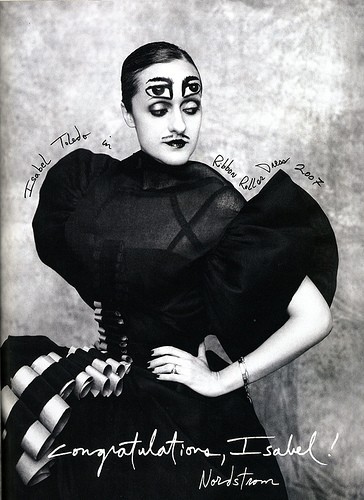
Cuban-American designer Isabel Toledo has been called a “radical classicist.”* A cult figure known for her brilliant pattern-making, Toledo’s fortunes with the mainstream fashion press had waxed and waned until Michelle Obama wore a custom Isabel Toledo ensemble to Barack Obama’s first presidential inauguration in 2009. Later that year, the FIT exhibition Isabel Toledo: Fashion from the Inside Out brought the designer’s work to a wider public. (View the online exhibition here; see Michelle Obama’s Lemongrass dress and coat and listen to Valerie Steele’s commentary here.)
Toledo refers to herself as a seamstress; she says she learned pattern-making from Vogue patterns. (See her 1997 interview in Index magazine.) Her volunteer work at the Metropolitan Museum of Art’s Costume Institute also gave her unique insights into construction as practiced by master couturiers such as Balenciaga, Grès, and Vionnet.
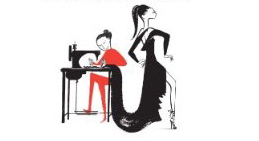
Toledo’s innovative pattern-making makes her a natural favourite for home sewers. In the mid-1990s, a handful of Isabel Toledo patterns were released through the Vogue Attitudes line. The July/August 1995 issue of the magazine introduced the designer:
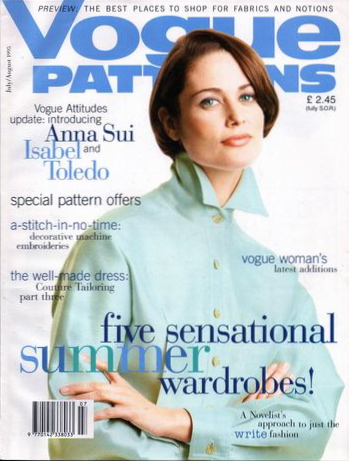
The magazine cover shows the shirt from the first Isabel Toledo pattern, Vogue 1608—a design for a peplum shirt, sleeveless top, skirt, and pants:


Here’s the envelope description: Misses’ top, skirt & pants. Loose-fitting, blouson (back) top A has collar and band (cut-in-one), lined yoke, forward shoulder seams, front bands, back pleat, self-lined peplum and long sleeves with pleats and button cuffs. Fitted top B has princess seams, armhole binding and hem slits. A-line skirt, above mid-knee or tapered pants, below ankle, have button waistband. C: side front and side back seams, back zipper and narrow hem. D: seam detail, stitched hems, back slits, and side button opening.
Toledo and her new design were also featured on the cover of the store catalogue:
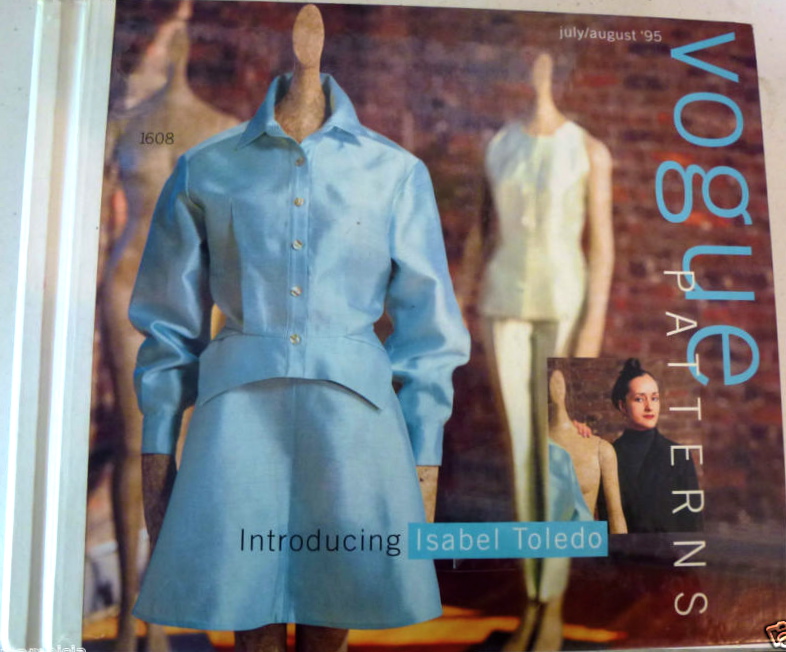
Vogue magazine had published an article on Toledo earlier that year (Sally Wadyka, “A Structured Life”). The pink organza shirt jacket on the right looks like a variation of the Vogue 1608 shirt:
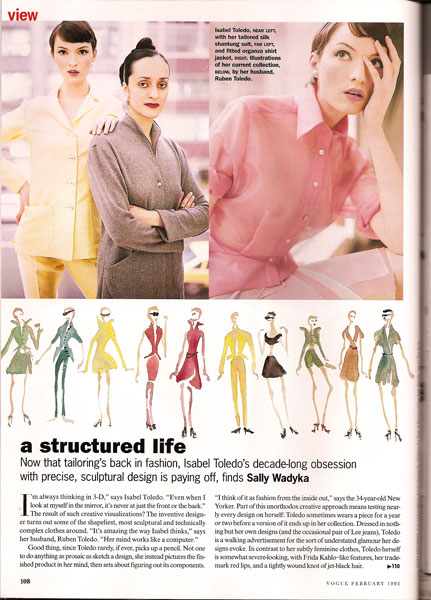
Vogue 1869, a pattern for a jacket, stretch-knit top, and bias pants, was the focus of a two-page feature in the November/December 1996 issue of Vogue Patterns magazine. The feature draws attention to the jacket’s special construction—it’s underlined with fusible tricot knit interfacing, and the welt pockets are cut on the bias for a shaped effect. This pattern is in the collection of the Commercial Pattern Archive:
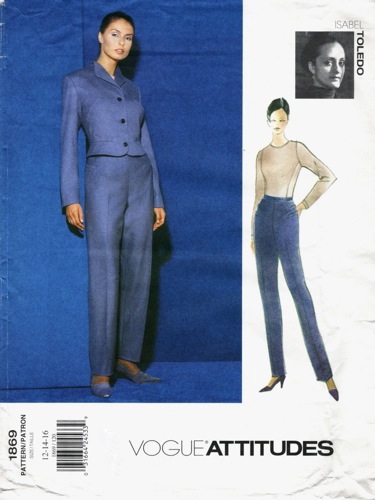

The envelope description reads: Misses’ jacket, top & pants. Fitted, partially interfaced, lined, below waist jacket has front extending into standing back collar, slightly extended shoulders, shoulder pads, front extending slightly to side back, no side seams, seam detail, welts, armhole piping and long, two-piece sleeves with button vent. No provision for Above-Waist Adjustment. Close-fitting, pullover top has back extending to side front, no side seams, stitched hems, back zipper and long sleeves. Bias, lined, tapered pants have back button waistband, front/back welt pockets/welt trim, no side seams, back seam detail and back zipper. (Top for stretch knits only.)
Vogue 2043, a pattern for a shirt, skirt, and pants, appeared in the January/February 1998 issue of the magazine, in the Shop Vogue section:


Here’s the envelope description: Misses’ shirt, skirt & pants. Loose-fitting shirt has collar, dropped shoulders, front bands, side back extending to front (forming pleats), princess seams, shaped hemline and long sleeves with placket, pleats and button cuffs. Narrow hem. Semi-fitted, tapered, lined skirt, above mid-knee, has back button waistband/zipper/vent. Slightly tapered, lined pants have narrow waistband and side zipper.
For me, the highlight of the series is Vogue 1748, a pair of dresses for stretch knits:

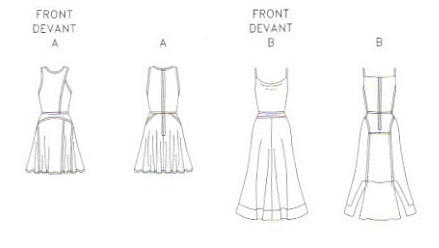
The envelope description reads: Misses’ dress. Dress, above mid-knee or above ankle, has close-fitting bodice, yoke variations, slightly flared or flared skirt with seam detail and back zipper. A: front princess seams on bodice, mock wrap skirt. B: bias shoulder straps. draped front neckline, shaped hemline, side back slits and stitched facings.
Vogue 1748 shows some similarities with garments included in the FIT exhibition, perhaps best seen in the catalogue’s technical drawings:
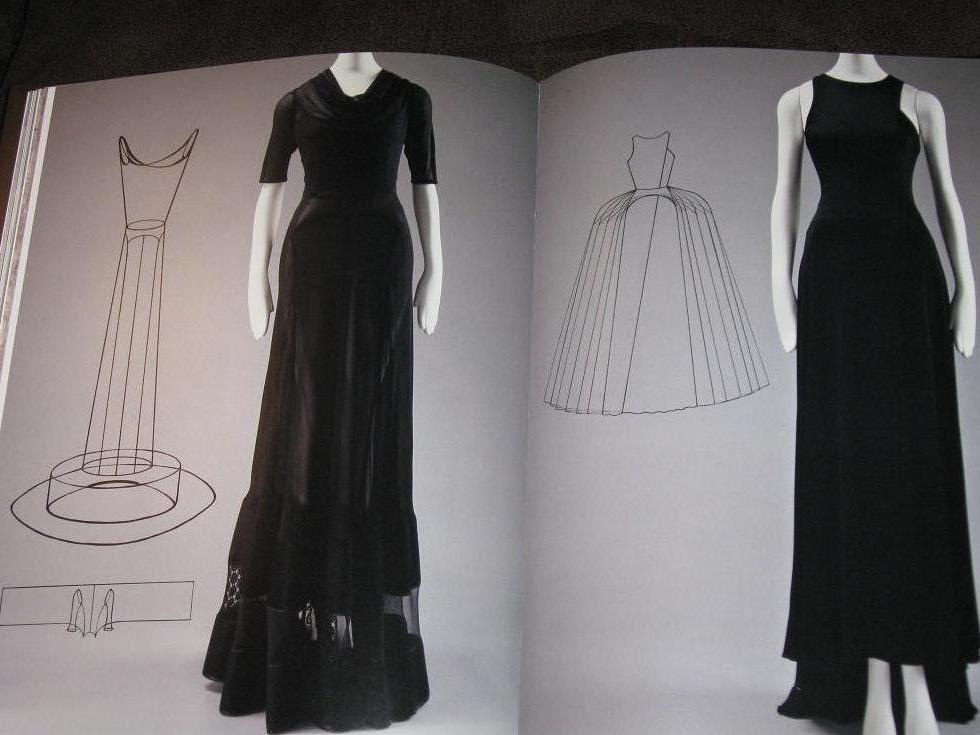
The Pedestal dress (left), from Toledo’s Fall/Winter 1994-95 collection, can also be seen in the online exhibition; the Tanker dress (right), from the Spring/Summer 1992 collection, has the same bodice detail and hip yoke as view A of Vogue 1748.
Isabel Toledo’s collaboration with Vogue Patterns downplays her experimental side in favour of her genius for construction. Yet as a browse through the stunning pieces in FIT’s online exhibition and catalogue shows, the patterns are consistent with Toledo’s play, in the ’90s, with two- and three-dimensional geometric shapes in relation to the body.
* Susan Yelavich quoted in Valerie Steele and Patricia Mears, Isabel Toledo: Fashion from the Inside Out (Yale University Press, 2009), p. 64.
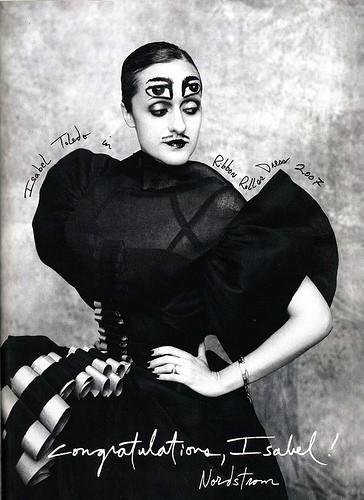
Leave a reply to Becky bushbunny Cancel reply